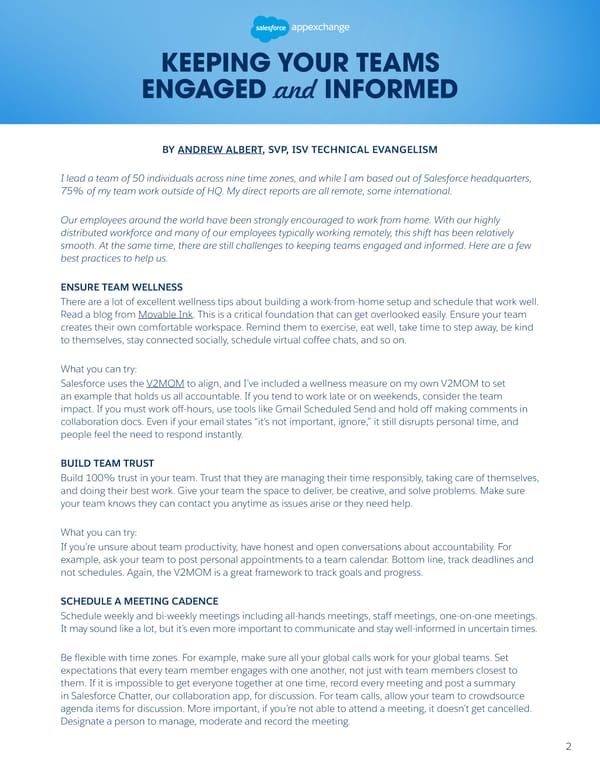KEEPING YOUR TEAMS ENGAGED and INFORMED BY ANDREW ALBERT, SVP, ISV TECHNICAL EVANGELISM I lead a team of 50 individuals across nine time zones, and while I am based out of Salesforce headquarters, 75% of my team work outside of HQ. My direct reports are all remote, some international. Our employees around the world have been strongly encouraged to work from home. With our highly distributed workforce and many of our employees typically working remotely, this shift has been relatively smooth. At the same time, there are still challenges to keeping teams engaged and informed. Here are a few best practices to help us. ENSURE TEAM WELLNESS There are a lot of excellent wellness tips about building a work-from-home setup and schedule that work well. Read a blog from Movable Ink. This is a critical foundation that can get overlooked easily. Ensure your team creates their own comfortable workspace. Remind them to exercise, eat well, take time to step away, be kind to themselves, stay connected socially, schedule virtual coffee chats, and so on. What you can try: Salesforce uses the V2MOM to align, and I’ve included a wellness measure on my own V2MOM to set an example that holds us all accountable. If you tend to work late or on weekends, consider the team impact. If you must work off-hours, use tools like Gmail Scheduled Send and hold off making comments in collaboration docs. Even if your email states “it’s not important, ignore,” it still disrupts personal time, and people feel the need to respond instantly. BUILD TEAM TRUST Build 100% trust in your team. Trust that they are managing their time responsibly, taking care of themselves, and doing their best work. Give your team the space to deliver, be creative, and solve problems. Make sure your team knows they can contact you anytime as issues arise or they need help. What you can try: If you’re unsure about team productivity, have honest and open conversations about accountability. For example, ask your team to post personal appointments to a team calendar. Bottom line, track deadlines and not schedules. Again, the V2MOM is a great framework to track goals and progress. SCHEDULE A MEETING CADENCE Schedule weekly and bi-weekly meetings including all-hands meetings, staff meetings, one-on-one meetings. It may sound like a lot, but it’s even more important to communicate and stay well-informed in uncertain times. Be flexible with time zones. For example, make sure all your global calls work for your global teams. Set expectations that every team member engages with one another, not just with team members closest to them. If it is impossible to get everyone together at one time, record every meeting and post a summary in Salesforce Chatter, our collaboration app, for discussion. For team calls, allow your team to crowdsource agenda items for discussion. More important, if you’re not able to attend a meeting, it doesn’t get cancelled. Designate a person to manage, moderate and record the meeting. 2
 AppExchange Business Playbook Page 2 Page 4
AppExchange Business Playbook Page 2 Page 4